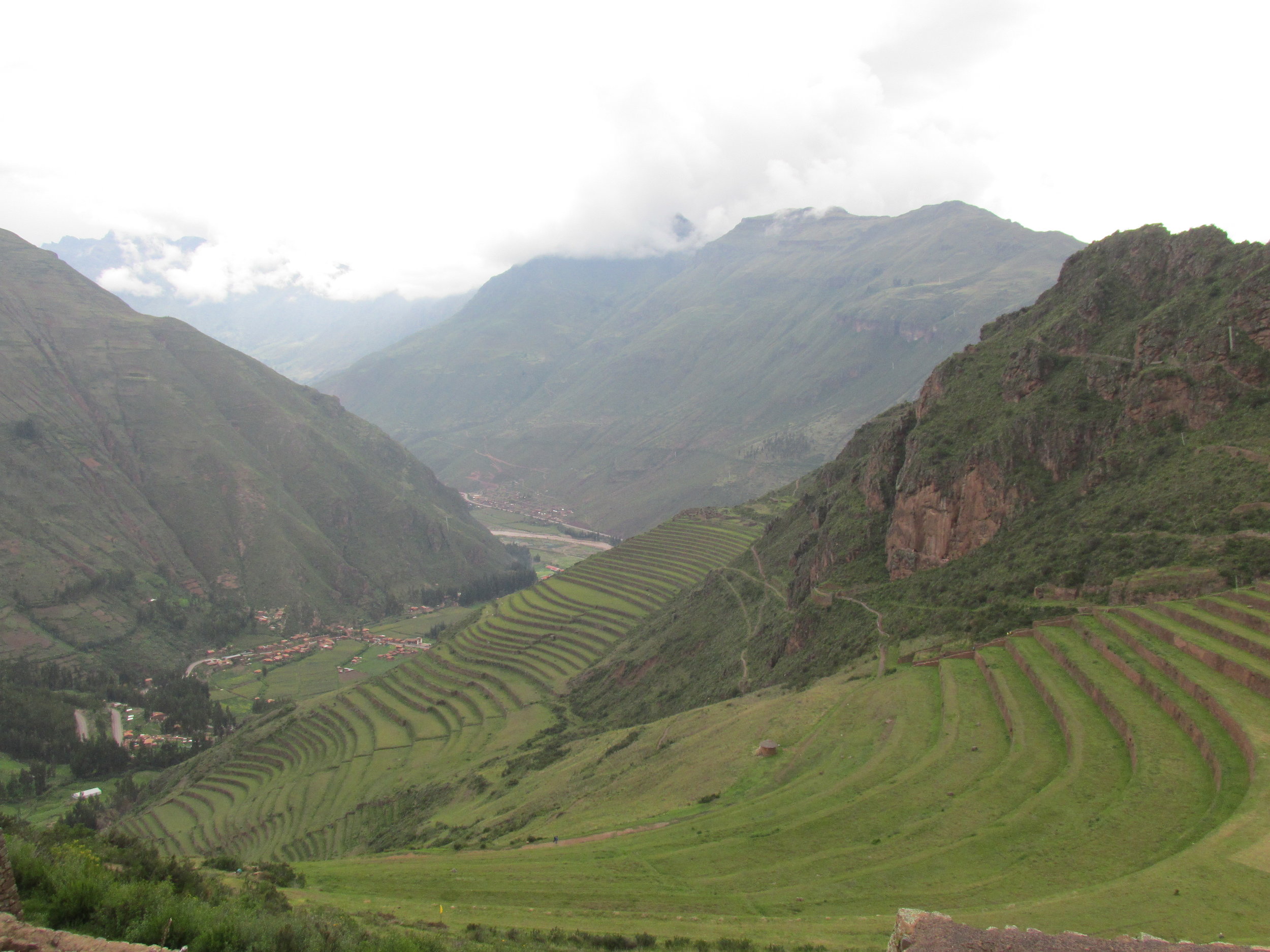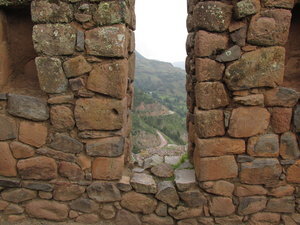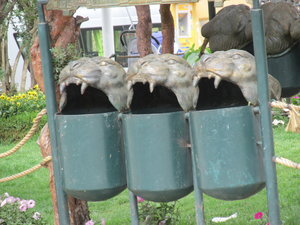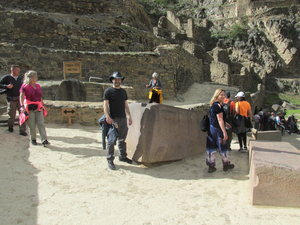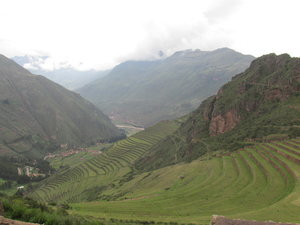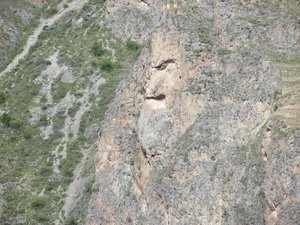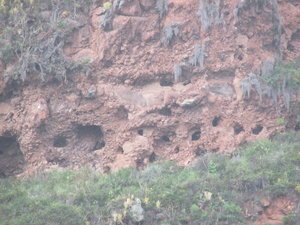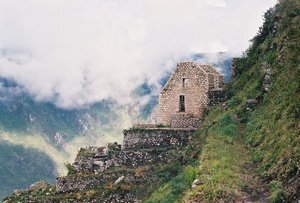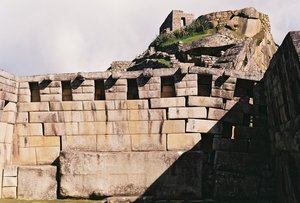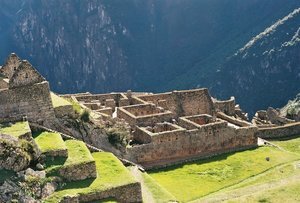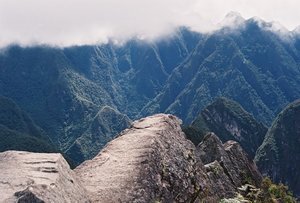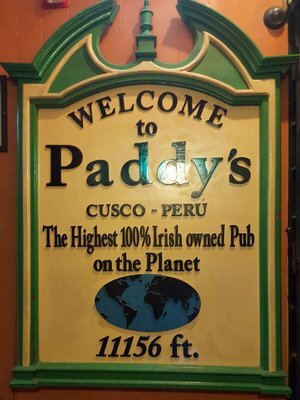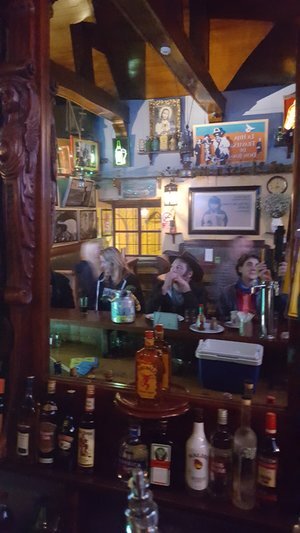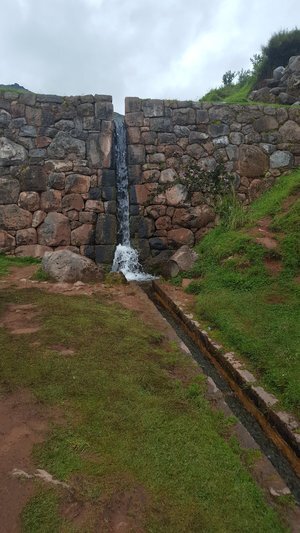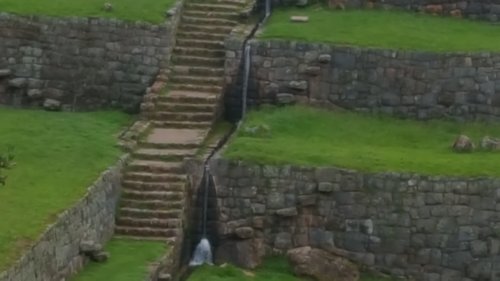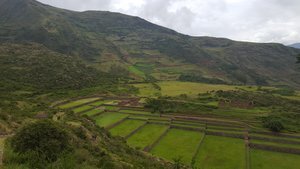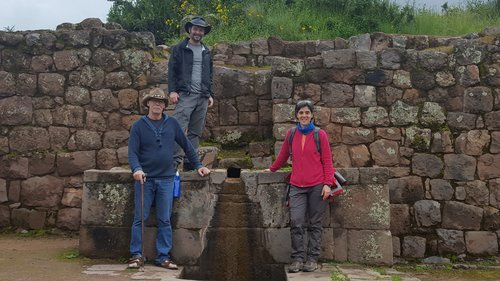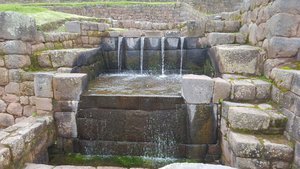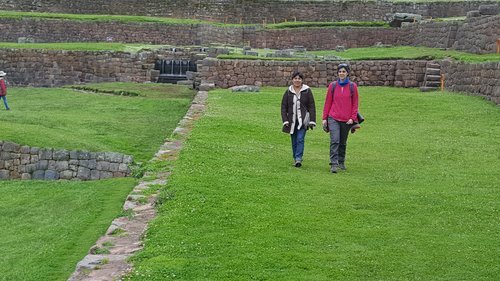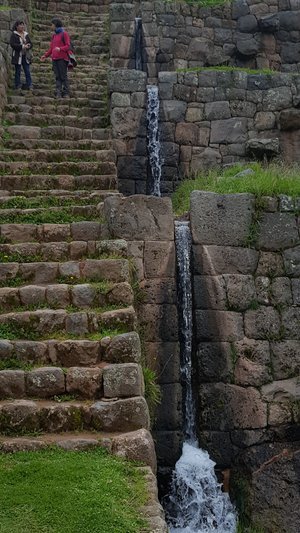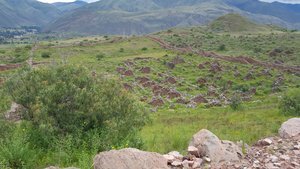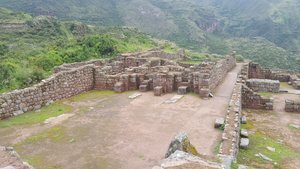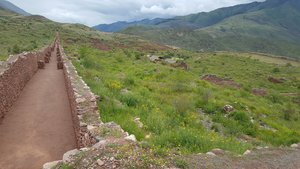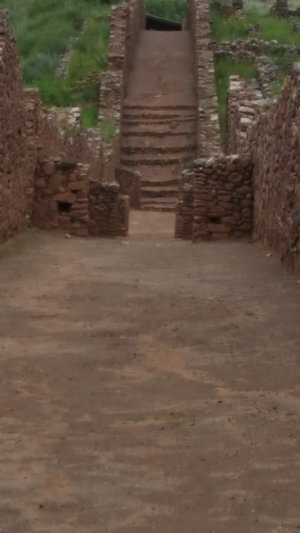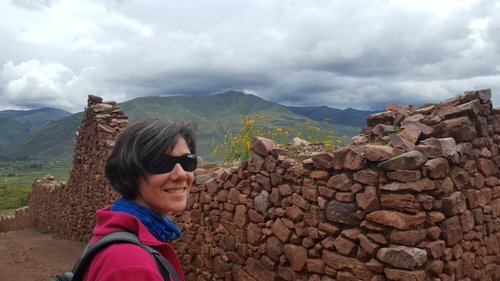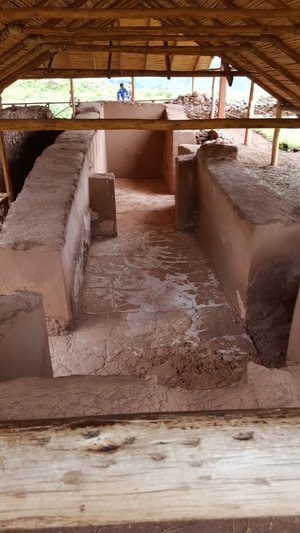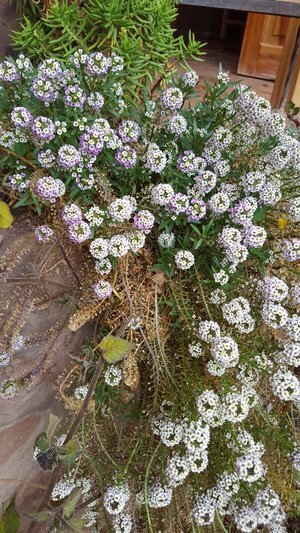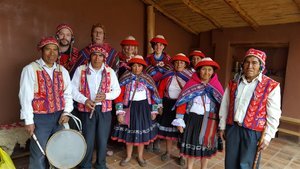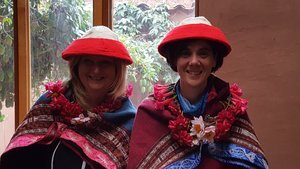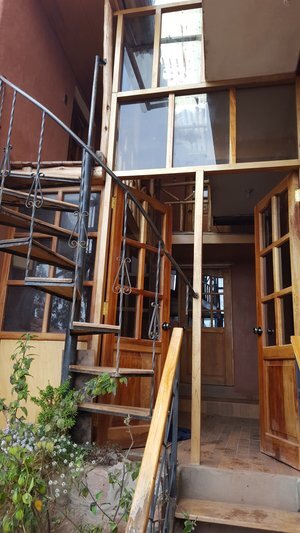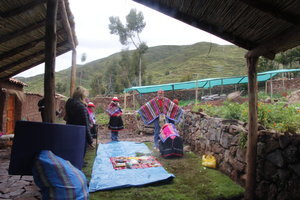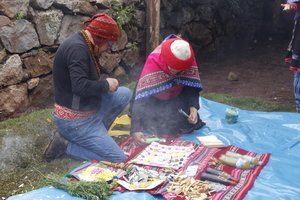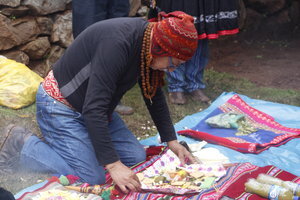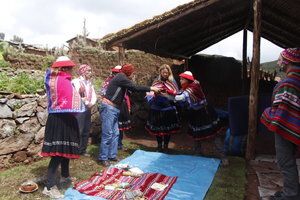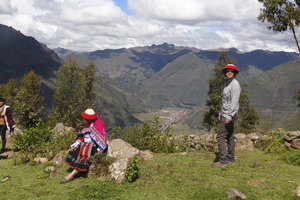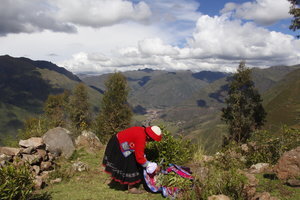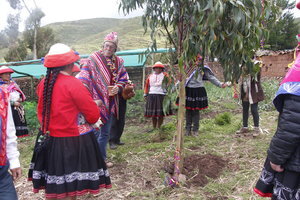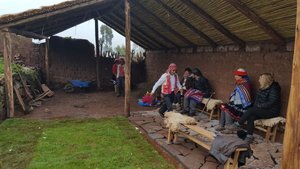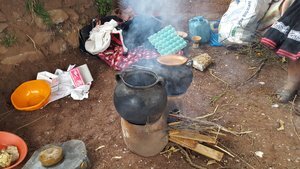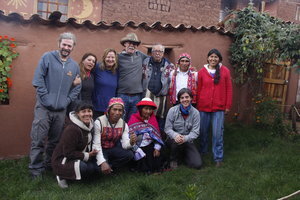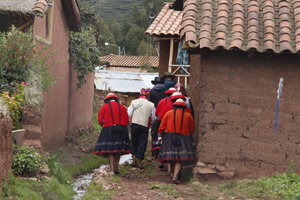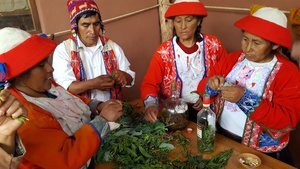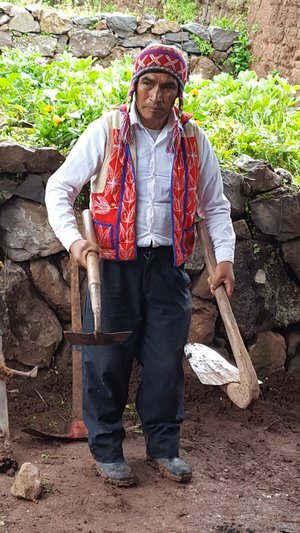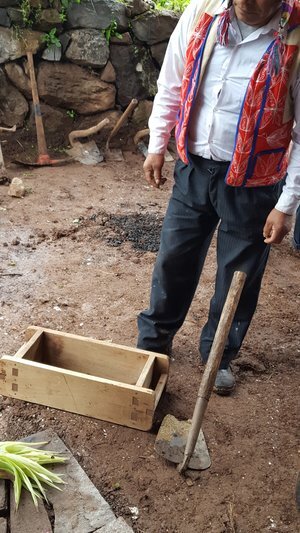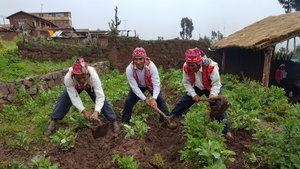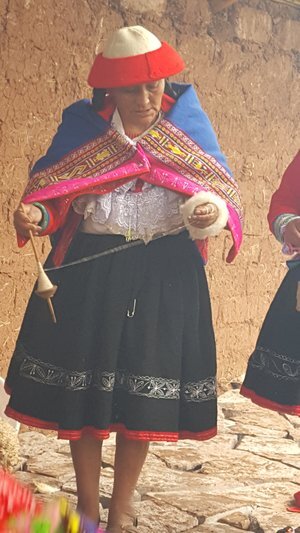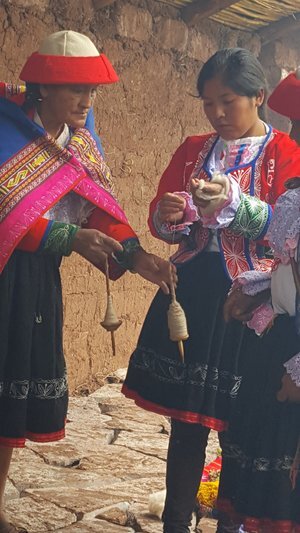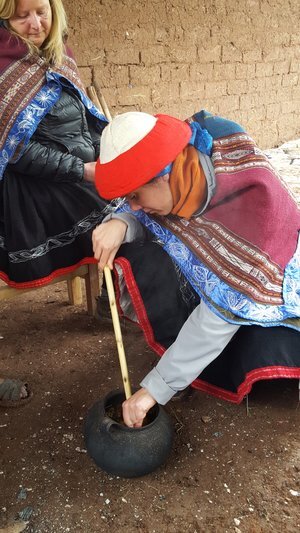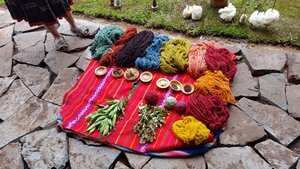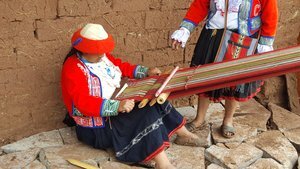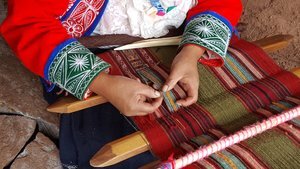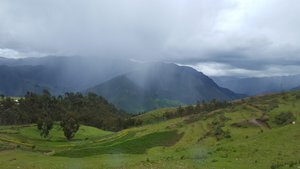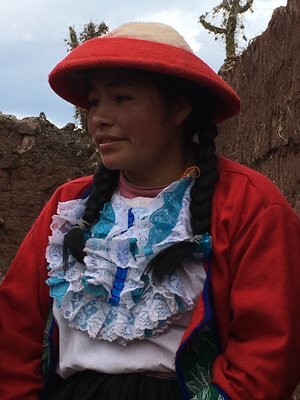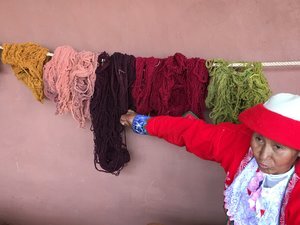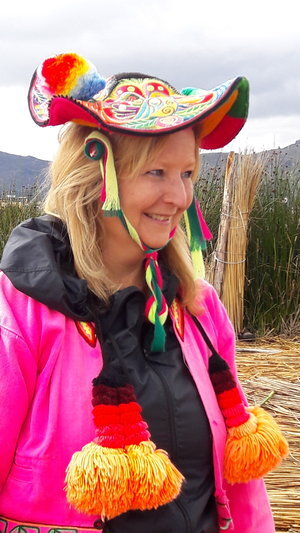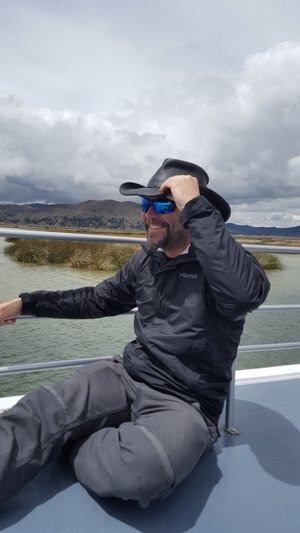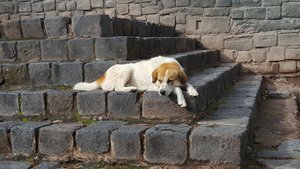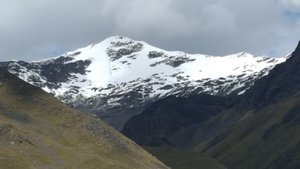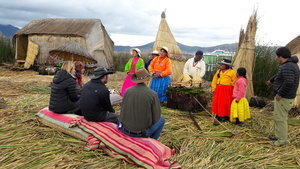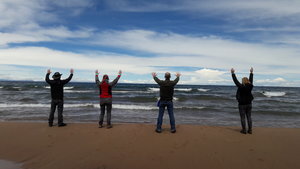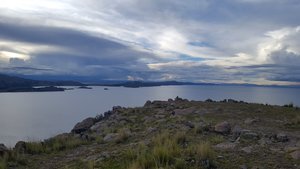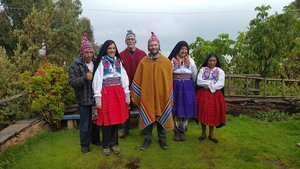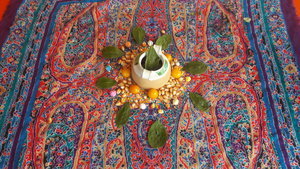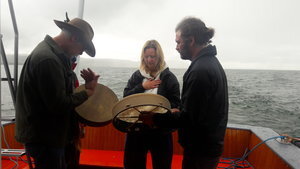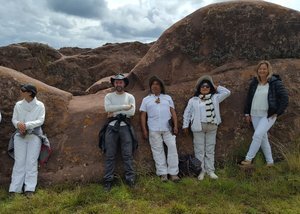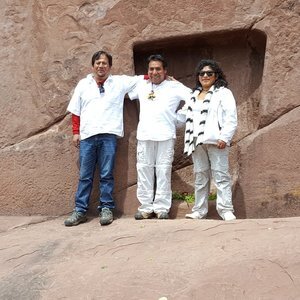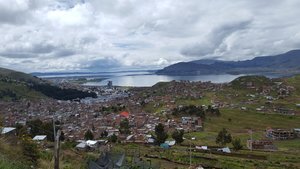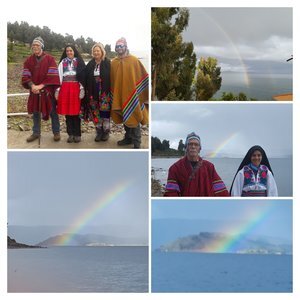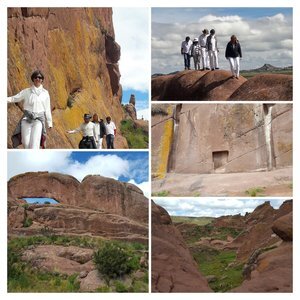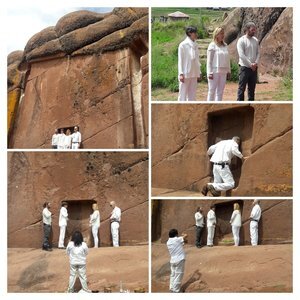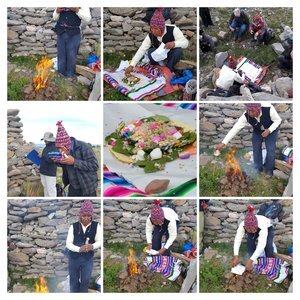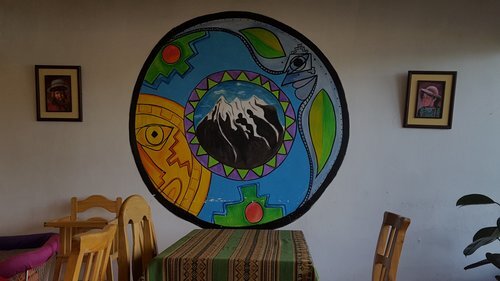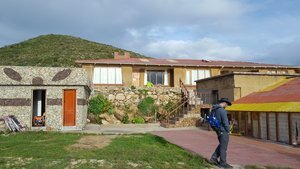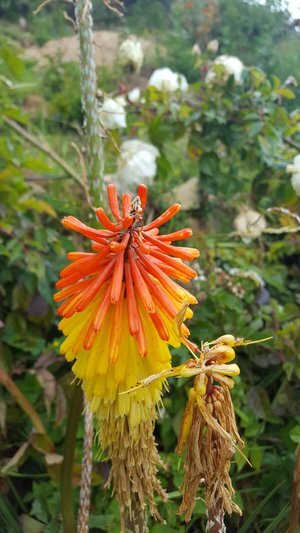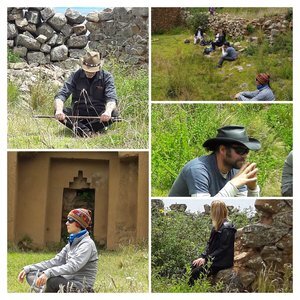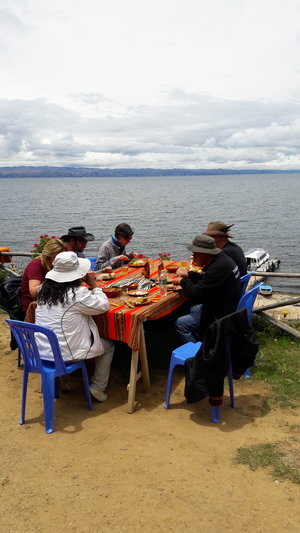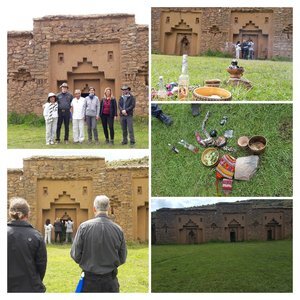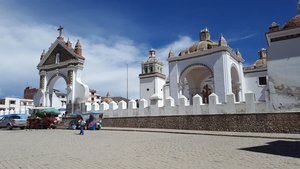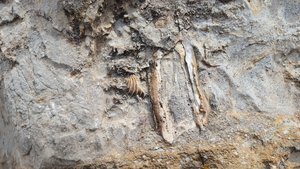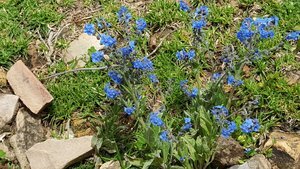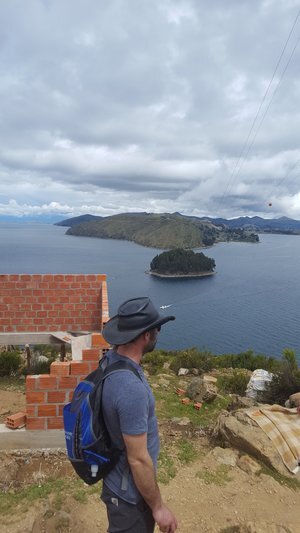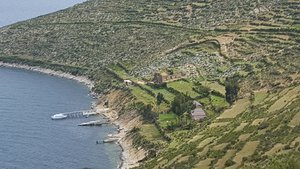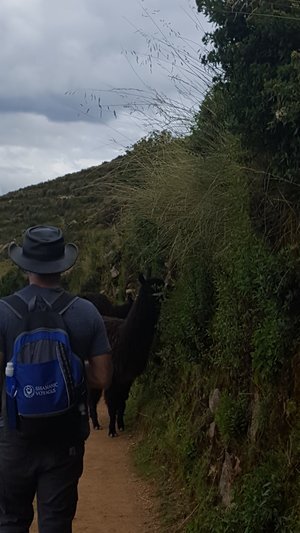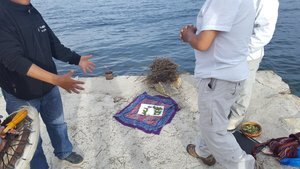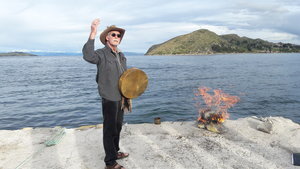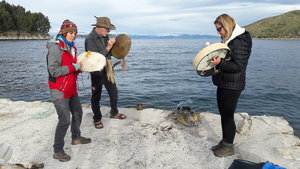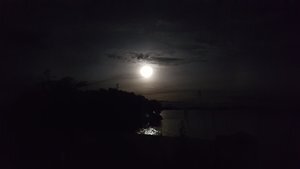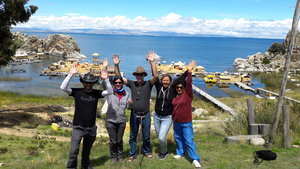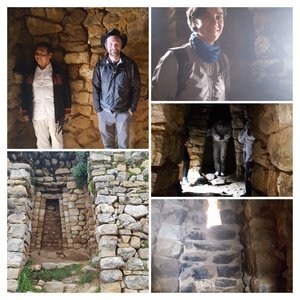The Andes of Peru and Bolivia 2018
19/feb/2018-4/March/2018
Shamanic Voyages trip through the Andes of Peru and Bolivia was, as stated, not for the faint of heart. With most of our travels taking us between 9,000 and 14,000 ft, (2745-4265m), above sea level, it was sometimes hard to get your breath. Or perhaps the scenery just took the breath away, it’s hard to say, but it was worth every effort.
The group was great about following the advice on how to minimize the effects of Sorrache, or altitude sickness, and with the exception of a bit of sunburn, there were no serious problems during the entire trip.
After meeting up at the Lima airport, we flew together to Cusco , the real starting point of the trip. We were met at the airport by Lilia, our delightful interpreter for our stay in this region.
After resting and adjusting to the altitude at our hotel, Casa de Elena, we wasted no time in exploring the city and its nearby environs. Our second day in Peru took us through the Sacred Valley along the Urubamba river, stopping in Pisac, Ollantaytambo and finishing up in Aguas Calientes, just below the ruins at Machu Picchu.
The Pisac of today is located down along the river and is largely an artistic community with a large market, that stands below the ruins of ancient Pisac, located further up the mountainside. Here in old Pisac, we saw a complex of agricultural
terraces which were engineered with layers of different soil types and stones to maximize their efficiency for crop production. There were also impressive stonework buildings, monuments and the funerary caves where many remains,... well, remain.
Ollantaytambo, also terraced, served as a military outpost and travelers sanctuary. The terraces here were not thought to be used for agricultural purposes, but for strategic ones. Here too, the stonework is impressive, as is the enormous face in the rock
outcropping that overlooks the settlement, (see photo in slideshow above).
Upon our arrival in Aguas Calientes, now called Machu Picchu Village, we met with a downpour of biblical proportions, but were still dutifully met and conducted to our hotel. It was the end of the rainy season after all, which was responsible for the beautiful
colors the countryside had to offer at this time of year. The river that passed by the rear of the hotel roared wonderfully. Here we would spend our second night.
The morning of our third day dawned misty and cool. We were now in the cloud forest, where the vegetation was distinctly different from what we would see during most of our trip. We caught the bus in the village that would bring us up to the ruins of Machu Picchu . The ride took about twenty minutes, ascending the mountain in a series of hairpin turns. Arriving at the entry gate, I could hardly recognize it as the same place I
had visited seventeen years ago, and I admit it took some effort to remain positive about the changes.
Now a UNESCO world heritage site, Machu Picchu has come under stricter visitation regulations in order to protect this important place from the unintended consequences of thousands of people entering the site daily. Many areas are now off-limits to foot traffic, and tickets are limited to half-day visits. These changes are among many that have become necessary to ensure the integrity of this sacred place for future generations. But however regulated, the Beauty and Sacred Presence of this
place can’t help but strike you, especially when it is the first time you see it.
When we arrived at the entry path, the mist was hanging and rolling from the nearby peaks, with blue sky in between. Photographers wait weeks for the conditions that
greeted us that morning, and though the mandatory guide was sometimes a distraction from the scenery all around us, the power of the mountain won out. There was little opportunity to hold ceremony there, but many opportunities to pause and feel the
reverence that this wonderful place inspires.
We were able to detach ourselves from our guide for an hour or so before we left, to further explore along the marked trails and take photos, some of which are posted here. The afternoon and early evening were spent taking the train and bus back to Cusco.
We passed the evening by having dinner and a drink at Paddys’ Pub, ‘The Highest 100% Irish owned Pub on the Planet’, as the sign says. We took this opportunity to kick
back a little before beginning our fasting the next morning in preparation for the next phase of the trip.
Until now, much of our experience in Peru had been cultural and educational, learning about how the places and people we had come in contact with have been shaped by their connection to the great Inka civilization, and its persistent influence on their philosophy and daily life. As the trip proceeded, the shamanic
elements of this worldview would play a larger role.
On our fourth morning, we would visit Tipon and Pikillacta on our way to Patabamba. Tipon was stunning and I, for one, could have spent an entire day exploring there. The Fort and Temple were excellent examples of Inka architecture, but the
land works were amazing! Again the mountainside was terraced, but that was only the surface beauty. The real accomplishment here was what was constructed beneath the ground, intercepting and directing the groundwater into fonts and channels, the most
significant of which arose from the ground and passed through a single spillway into a pool, then through a pair of spillways into another pool and then from that pool through four spillways and into a third pool, from which water was directed away through the terraces. This water has been flowing like this for hundreds of years!
Pikillacta was our next stop, a pre-Inka city linked to the Huari civilization. The stone work here appeared somewhat cruder, but excavations have revealed that the walls were finished with plaster, giving a very clean and massive appearance to the
earthworks. The scope of this city was enormous, entirely surrounded by a double perimeter wall. Clearly the civil engineering employed here must have been an inspiration to later cultures.
After our two stops, we continued on to Patabamba . Situated at just over 13,000 ft, (4000 m), above sea level, Patabamba is an agricultural village with a tradition of producing hand made, traditional textiles of very high quality.
Having visited Patabamba before, I had become very fond of the people here, and was anxious to return. As before, we were welcomed with fanfare, complete with drums, flutes and dance. Upon entering the courtyard, we were showered with flower petals, then adorned with flower necklaces and traditional coverings for our clothing, ponchos for the men, skirts and shawls for the women, and hats for all. The welcome dance, at over two miles above sea level, can be exhausting! But even I, no dancer, had a blast!
After a light meal of soup, (according to our fast), I asked if we could use a nearby common space to hold a small ceremony for our group, this being our first real opportunity for any real privacy since arriving in Peru’. Our request was of course
granted. It was a bit of a surprise however, when all ten of our hosts showed up to join us!
We opened our ceremony with smudging and drumming. Our hosts were unfamiliar with sage, but were very respectful and showed restrained enthusiasm as each was
included in the cleansing ritual. We then honored the Directions with a tobacco ceremony, with the prayers being translated into Quechua by our interpreter, Lilia.
There was genuine interest in our observances and our shamanic tools, and once we concluded, the gratitude shown for including them was truly heartwarming. That night it rained, and it was cold, and we had to work for our oxygen. Consequently, none of us got a really good nights sleep, and were by then feeling the effects of fasting. So dawned our fifth day. The day of the Huachuma Ceremony.
Huachuma, (pronounced ‘wachuma’) is the Quechua name for what many know as the San Pedro cactus. It has had a long history as a sacred visionary medicine in the Andes, used by the shamans and the political nobility to gain teachings and wisdom.
When the Spanish priests tried to understand its importance to the local people by drinking it themselves, they renamed it ‘San Pedro’, as Saint Peter was the gatekeeper to the entrance of Heaven. With the formal designation ‘Trichocereus pachanoi’, Huachuma is still used as a visionary medicine by contemporary Andean shamans and Altomisayocs, (healers).
Its effects differ from person to person, it being understood that its user will receive what they need at that time. It is the policy of Shamanic Voyages not to share the experiences of others, nor to
require anyone to engage in a ceremony that they are not comfortable taking part in, or to divulge the names of those who choose to participate. That being said, the ceremony as held for our group proceeded as follows.
At breakfast we were served a thin porridge of oats, and were met by don Carlos, the Altomisayoc, and his assistants. After introductions and some brief instructions, we agreed to meet at the place prepared for our ceremony shortly after breakfast.
The rain had stopped just before sunrise and the sky had remained overcast, but we had expressed a preference for being outdoors. So our hosts had prepared a beautiful space for us in an outer courtyard a couple of hundred meters from where we were
staying.
The first part of the ceremony was the purification of participants, followed by the offering. Each person, in turn, whether drinking Huachuma or not, was smudged from a bowl of burning Sao Paulo and herbs, as blessings were given by don Carlos. He also used flower petals and agua de florida, a tincture of flower blossoms, as well. Nothing felt rushed as a sense of openness and reverence descended on our group. Some of
our hosts were there as well to hold space for us and engage symbolically in the ceremony. Once the Altomisayoc finished with the last of the purification, he began to prepare the offering.
There are many similarities in the preparation of the offering bundles that I have seen prepared in the Andes, as well as small distinctions intended to direct the prayers and offerings toward a specific concern. The offering of don Carlos on this morning
struck me as being particularly beautiful. Although much of what he said and did was interpreted through a translator, most of it was easy enough to follow just by tuning in to his actions. There were of course the usual symbolic gifts of food, sweets, money, llama fat and coca leaves, but there seemed to me that they were arranged and accompanied by prayers in such a way that it almost had the flavor of a musical composition. There was a rising and falling in his words and actions that revealed him as a master of his art.
His prayers were for the success of this community and its people, plentiful crops and the health of its children, they were also for us, and for the success of the personal journeys we were about to embark on.
The offering was then bundled up and tied together, passed through all of our hands, then conducted along a path to an area of cultivation, where a hole was dug for the bundle to be placed in. Once in the ground, each of us placed three coca leaves and
sprinkled some chicha, (a mild beer-like beverage made from corn), onto the offering.
The bundle was then buried in the earth to concluding prayers. We were then led back to the ceremonial area, to sit and wait for the Huachuma to be shared.
Don Carlos then addressed the Huachuma, presumably to ask it to help us, and then poured out small amounts, perhaps a teaspoon, to those not fully participating but wanting to take a supportive part in the ceremony. For those of us that would fully
participate, a coffee mug portion was poured, and we were instructed to drink it slowly, by sips. It was not the worst tasting potion I have consumed, but it is on that side of the taste chart. We were then led to mats where we were encouraged to lie down.
Before I go on I just want to remind everyone, if Acetazolamide is the first thing to remember to take before going into the Andes, (for altitude sickness prevention), sunscreen is the second. Because the day began damp and cool, I didn’t think to
remind everyone to apply protection. As the ceremony proceeded, the weather began to clear and we were each given a personal lesson about the power of the Andean Sun.
Our individual experiences while with the medicine are not appropriate to share in detail, as with most work of this kind, to share the gift of the encounter too freely will dissipate its power. I will share however, the general scope of my time while with the Huachuma.
I held the clear intent of asking for a specific healing, or restoration for myself. While laying still, with the world continuing its business around you, it is easy for the mind to
wander, particularly as the quality of your senses begin to change. Coming back to ones intent, and remaining focused on it, delivers a clear message to the spirit that guides the journey. I was rewarded surprisingly quickly with a very clear and unambiguous answer that my request had been granted, from that moment forward I would be able to sense it. And I could. I was then instructed to relax, open my senses and receive gifts.
The ‘gifts’ were not so much things, or even visions of things, but the ability to see and hear things in a different way. I can’t remember being so drawn in by the changing images in the clouds since I was a child. I saw many images of death, but all held the
beauty of transformation. Even sounds that at began as an intrusion or an annoyance, shortly became almost musical as I adjusted my listening. It is my sincere hope that some elements of this lesson will remain with me.
Huachuma, like other visionary medicines, will bestow different experiences to different people. The common understanding is that you will receive what you need. And like Ayahuasca, it is a poor choice for someone seeking a recreational drug experience. My advice is to master the basics of shamanic journeying before working with these power plants.
After a time determined by the Altomisayoc, we were led away from the ceremonial area for a walk through nature, and in this case to a spectacular vista of the Sacred Valley, which Patabamba is perched above. The view of the surrounding mountains and
the valley below is unforgettable. There we rested and talked, shared some of our impressions of our experience, and held a closing ceremony.
Afterward, a couple of our group did some drumming which again attracted the interest of some locals. After a light
dinner we shared some social time with don Carlos and his assistants before calling it a night.
The next day, our sixth, we spent with our hosts, the natives of Patabamba. This was their opportunity to share with us their skills and lifeways. There is a division of labor between men and women here, though social parity appears to rely more on age than gender.
The men of the village are without exception, farmers. Some may have particular skills that are shared or bartered, but all take part in the day to day tasks of the community agriculture.
The women are almost all engaged in the production of textiles. Some excel others in weaving skill, but from collecting the plants and minerals for dyes, to spinning threads and yarn, to working the looms, all take part. Cooking and cleaning appear to be shared more or less equally.
The early part of the day was spent watching some of the men describing the use of the traditional tools and techniques that are used in maintaining their fields, many of which go back untold generations. They then demonstrated the seasonal practice of
mounding additional soil around their potato crop to increase its yield. I suspect that they were better dressed for this on our account than they would normally be, but it made for a good photo opportunity.
The early afternoon was spent watching the women demonstrate spinning with drop spools, washing and dyeing yarn, showing how the dyes are made and applied, and weaving on the simple looms you can see in the accompanying photos. Even though modern fabrics and dyes are occasionally used by the locals here, it is a point of pride to them to continue to use the traditional methods and point out the differences when
displaying their goods. The skill and technology they employed were fascinating! After their demonstration, we were allowed to look over their work and purchase some to take
home with us.
We had a farewell lunch with these pleasant people and reluctantly took our leave after being escorted back to the road out of the village, again with drumming and music. It is my hope that Patabamba will retain this balance of traditional ways and the
economic opportunity that rural tourism provides, and I am grateful those who work to maintain this delicate balance.
After leaving Patabamba, we returned to our hotel in Cusco, Casa de Elena. Though we never spent two consecutive nights there, we were permitted to keep our rooms and leave the bulk of our luggage there while making our side trips. I will very likely make this my home base in future trips to Cusco.
We spent our last night in Cusco eating, shopping and relaxing. This marked the end of our stay in this part of the country. The next morning we would depart for the Southern part of our trip across the altiplano, (high planes). This trip would mark our halfway point.
We boarded the bus for Puno early on the morning of our 7th day. The bus made four stops along the way for leg stretching, visiting sights along the route and lunch. It made for a full day of being on the road, but the scenery of the altiplano was wonderful.
We reached the highest elevation of our trip as we passed through the community of La Raya at 14,200 ft, (4335 m), above sea level.
When we arrived at the Puno station, we were met by don Hermogenes, the shaman that would accompany us on the remainder of the trip. While in Puno we would stay in the very comfortable Hotel Hacienda, just off the main plaza. Our first stay here was short however, with an early departure
scheduled for the next morning. We spent a couple hours downtown, had dinner, and called it a night.
Puno is the main Peruvian population center situated on Lake Titicaca. On the Northwestern shore of the lake, Puno is home to about 150,000 people, and borders a large bay. We departed from the main docks in a private boat for our travels on the Peruvian section of the lake.

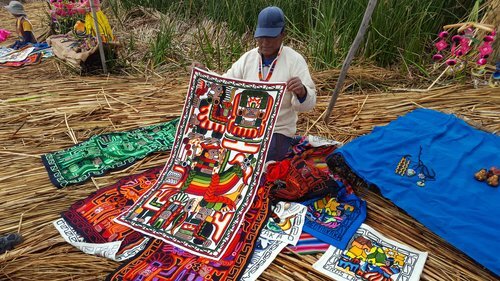

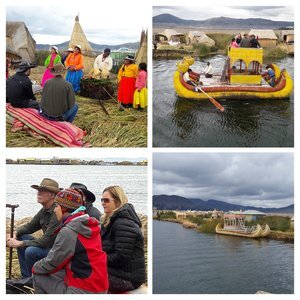
Not far offshore is a collection of floating reed islands known collectively as the ‘Uros Islands ’. This was our first destination of the day. The islands here are made from ‘Totora’, a reed that grows along the shore and in shallows of the lake. Huge mats
of these reeds form the floating platforms upon which the houses are built, (of the same material). These Islands stay afloat for decades before having to be rebuilt, and are home to entire families.
Each good sized island takes a turn hosting visitors for one day, on a rotating basis, in order to give each island an opportunity to sell their crafts to tourists, while preserving their traditional ways the rest of the time. The islanders are proud of their distinct culture and are striving to maintain it against the pressures of
modern civilization. You can even have your passport stamped with an Uros stamp!
Later that morning we continued on to Taquile Island, for our first ceremony with don Hermogenes. This took place on the beach of the island facing the snow capped Andes mountains in the distance. Film can never capture the absolute splendor of a scene like this. As the ceremony concluded, a group of three Taquile islanders snuck up behind us and began to drum and play traditional music. When they finished, we exchanged greetings and were invited to lunch. After a brief rest, we hiked over the island to the opposite shore where our boat met us for the last leg of the days voyage to Amantani Island, our days final destination.
Amantani Island is home to the Pachamama Temple , which is located at the summit of the island. Many of the homes on the Island have been expanded to accommodate visitors by adding rooms and basic amenities, but the community itself continues to hold a rustic charm. The lake rests at 12,500 ft, (3800 m), with the summit rising to 12,950 ft, (3950 m), a steep ascent, particularly for we lowlanders! After a brief stop to drop off our luggage, we met the challenge and hiked the trail to Pachamama
temple. Looking back as we ascended, we were treated to spectacular views, but at the top, the vista toward the opposite side was incredible. This side of the island, below the temple, dropped off even more steeply and afforded a view of a small archipelago of islands in the foreground continuing to open water and the opposite shore with the Andes in the distance.
The temple itself was closed for restoration work, but there were smaller stone structures scattered about, and we met an Altomisayoc who don Hermogenes had contacted to perform the local rites at one of them. His name was don Francisco. As
before, an offering was prepared of similar items as in Patabamba, with only minor differences, and the prayers were in Spanish and Aymara, rather than Quechua.
Aymara is the dialect spoken around the Lake since ancient times, and was the language of the first Inka, who was said to have come from this region. This time the offering was burned after all the participants took part by breathing a blessing into the bundle. See the series of photos.
The sun was low in the sky as the ceremony ended. The walk back to our host family was fairly rapid, as gravity was assisting us all the way down. We rested for a bit, then shared an evening meal with our hosts just after sunset. During the night there were
thunderstorms, adding the sense of yet another mantle of power over this place.
The morning of our ninth day gave us a series of rainbows. After waking to one, we had breakfast and then packed our things for our return to Puno. Our hosts requested that we wear the local attire while phones and cameras were passed around, as the
evidence will show among the photos. As we prepared to board our boat, another rainbow courteously appeared for a backdrop for another photo opp.
We took our leave just before mid-morning and headed out across the open water. Near the halfway point, don Hermogenes, by now known as Hermo, prepared an offering for the Lake, with each of us taking part in the assembly. As we drummed, Hermo placed the bundle into a ceramic jar which one of our group, Patricia, dropped from the stern into the water.
We arrived back in Puno by early afternoon and checked back into our hotel. The business of Bolivian visas still had to be taken care of for two of our group, and Berta, Hermos wife, helped us navigate the consulate. The rules had changed since I was last
here, requiring forms to be filled out on the Bolivian State Website. If it were not for Angelique, our comrade from France and Computer Engineer, we would have been unable to get the visas issued. As it was, Patricia and Jonah just made it back to the
consulate with the completed printouts as it was preparing to close. Once this business was completed we were free to wander the city and enjoy ourselves. Which we did.
Day ten we had an early breakfast and left for Bolivia. Happily, Berta was able to join us for this last part of the trip. She speaks English with a fair amount of confidence, and had been a good friend the last time I was here, so I was pleased she could join us. She and Hermo made a fine pair as well, balancing the male and female energies. On the way to the border it was our plan to visit the Temple of Aramumuru , or as it is sometimes referred to, the Star Portal .
The tradition, as Hermo observes it, is to follow the process of activating the energy of the primary spirits of the lower, middle and upper realms, represented by the Serpent, the Puma and the Condor. We dressed in white for this ceremony and were dropped off by our driver at a huge stone feature that resembled a snake. We began by climbing onto the snakes back at its head. The ridge along the back was narrow and ranged from three to five meters in height. We made a respectful procession from head to tail to
honor the lower realm and activate our energetic centers.
After dismounting the tail, we next walked the path of the Puma, or Cougar, and relaxing our stances and taking in the all the features of the landscape with all our senses, we crossed the terrain in the spirit of harmony, until we reached the place of the
Condor. This is a natural feature of the rock, and it does not require much of an imagination to see the resemblance of the cliff side to a huge Condor, as you can see in the photo. Here we honored the great bird and the realm it represents, the upper, or
ascendant realm. We then passed the Condor and followed the trail down to the temple.
As we approached the temple, my thoughts were with Nanouk, Co-Director of Shamanic Voyages, who was really looking forward to taking part in this ceremony, but
was unable to make this trip. Today was her birthday, and we invited her to join us in spirit.
If you look at the photos of the Temple of Aramumuru, you will see a shallow doorway cut into the rock wall with a vertical channel that rises to the top on either side.
Hermo and Berta prepared the offering, then Hermo used cleansing smoke to clear and purify our energy fields. Prayers were offered, as were the always present coca leaves.
Once we were all prepared, we were instructed to approach the temple one at a time, and beginning at the right channel, to stand within the space, face the wall, raise our arms and touch the stone, offering our personal prayer. When finished, we moved to the
doorway, and kneeling, placed our hands on the shelves to each side and our foreheads into the shallow depression in the rock wall.
Here I sensed what could almost be described as a very light current of electricity coming in from my head and exiting through my hands and knees. I’m not sure how long I remained like this, probably not long, but I experienced a dream-like vision of myself falling forward through the door, opening my eyes and finding myself in the same position on the other side. When I opened my actual eyes, I hadn’t moved from my position, and the sense of the current had ceased.
The observance finished by stepping into the left side channel facing outward toward the sun, again raising our arms in salute. Once we had all completed the ritual, we closed the ceremony, took some photos and exited the area by a nearby path to where our driver was waiting.
The Bolivian border was our next stop. It was quite the change in perspective from having just experienced the energy of Aramumuru. We had our passports stamped with exit visas on the Peru side, then had to walk a few hundred meters across the border to the Bolivian side and present our passports there. I’m not sure why they enforce this practice, but everyone must cross on foot, and luggage gets piled onto a bike taxi and is pedaled across by a local. The border itself is delineated by a short wall with a large arch, with a small ‘no mans land’ on each side. Having our visas issued ahead of time permitted us to pass through with little delay.
We met our new driver and Juan Carlos on the other side, who would take us on to Copacabana . Juan Carlos would be joining us for our travels in Bolivia. A native of Copacabana, he is a delightful and knowledgeable guide who I had traveled with before.
We had lunch and a brief tour of Copacabana before once again boarding a private boat and journeying back onto the lake. Copacabana Bay is beautiful and serves as a destination for many travelers as well as a departure point for those visiting the Islands
of the Sun and the Moon. Our destination for today was the Hospedaje Ecologico, on the Island of the Sun, where we would spend the next two nights. The trip took two hours. The balance of the day would be for rest and dinner.
The Hospedaje Ecologico is a family run inn perched on a point of land that gives the impression of seclusion, but is in fact only a short walk from the Temple of the Sun. It has two stone and concrete jetties, one on each side, that permit gentle docking, (or swimming), regardless of the prevailing wind. With solar collectors and a generator, hot water and electricity are, if not abundant, at least intermittently available. The rooms are
large and comfortable, and the food was very good. This was the first time I have stayed overnight on the island, and when I return, I have no reason to stay anywhere else.
Our eleventh day started out overcast. After breakfast we headed out with our daypacks for the Temple of the Sun . As we approached the temple a light rain started.
We entered the temple before getting wet, and assembled inside for a ceremony. As Juan Carlos explained the historical significance and astronomical purposes for which the temple was used, Hermo prepared the offerings. In this chamber of the temple there was a niche in the wall large enough for a person of moderate stature to stand and chant. The acoustics of the chamber made the chanting resonate nicely, and we each took our turn after making our offerings. Unbeknownst to us, as we were doing this, outside it was hailing. By the time we left to go to the solstice chamber, the hail had stopped. Each chamber was lighted by an opening, and in the solstice chamber the opening was strategically placed to identify the winter solstice, locally around June 21. Each day a villager takes a turn as caretaker for the temple, and as tradition tells it, so has it ever been.
When we left the Temple of the Sun, the sky began to clear. We threaded our way down the hillside to the dock located below the temple, where our boat was waiting for us. Our next destination was to be the Island of the Moon and its Temple of the Virgins, (or Maidens).
There is a story about the Island of the Moon that says that it was once a great serpent that rose from the lake, and that the Great Inka decapitated it in self defense. Today, at one end of the island, the high iron content of the soil gives it a deep reddish
appearance which defines where the serpents head was severed from its body. After rounding this point of land we approached the dock below the temple.
Because we arrived in a private boat, and fairly early, there were no tourists in the temple yard, and we had it to ourselves for the ceremony. As Juan Carlos explains: This temple was used for the initiation and instruction of young women. The majority of these
girls were selected from the general population for their distinguishing intelligence, or for some unusual characteristic, such as six fingers or unusual eye color. The girls were chosen at a young age, perhaps nine or ten years old. The families of these girls were willing to let them go, because of the great honor bestowed in their selection, and the better life they would have. Once initiated, they would receive an education and be instructed in special skills that would benefit the Inkan civilization. At some point in their mid teens, they would be free to choose whether they wished to return to serve their home communities, or join the nobility. The practical advantages of this system are
clear.
With the sun becoming stronger, we took part in another cleansing and offering ceremony conducted by Hermo with Berta assisting. It was particularly sublime, with the light, warmth and beautiful edifices surrounding us. Once the familiar part of the
ceremony ended, Berta led the women of our group to one of the portals of the temple to receive instruction, as the men remained in the center courtyard holding space. It somehow felt very right to include this in this place. Just as the women returned, tourists
began to arrive, and we found ourselves of great interest to people taking pictures as we concluded the ceremony. Juan Carlos then explained many of the meanings of the features and decorations of the temple. We lingered for some time before leaving for
our return to the Island of the Sun.
We landed on the Island of the Sun at some distance from our departure point. By now it was early afternoon and we were all quite hungry. We headed up the incline from the beach to a small compound that appeared to be an inn under construction. The
family here also ran a small outdoor restaurant where we were treated to a traditional Andean Buffet. A large platter was brought out with a variety of potatoes, beans, corn, some type of fritter, trout and a small fried fish that was eaten whole. With tea and
cerveza to wash it all down, it was a satisfying meal. Then, to work it all back off, we began our trip back to Hospedaje Ecologico overland, while our boat headed back without us.
I don’t know exactly how much distance we covered getting back, but there was a lot of ‘up’ involved. We had been living at around 12,000 ft now for almost two weeks, but it was still easy to get out of breath. I swear the locals must have three lungs! Once we attained some elevation, the scenery was again amazing, but with a beautiful foreground as well, as we passed through crops and ornamentals that were in flower.
Along the way, Jonah spotted some seashell fossils in a large stone that hearkened back to the time before the Andes rose up from the Pacific. Near the highest part of the path back, we passed through a large village, very scenic in its own right. Continuing
downward we had to share the path with llamas and tourists headed upward toward the village.
When we arrived at our rooms, it felt like coming home. After resting a while, I climbed up the hillside and drummed for a while among the grazing donkeys. When I finally stopped, I could hear someone else from our group drumming further down the
hillside, and I remember thinking, “this is the life…”. It was a bittersweet thought that tomorrow we would begin our return Northward again.
That evening we had a boisterous and extended dinner. By now our feelings of comradery with Berta, Hermo and Juan Carlos had deepened to real friendship, and the laughter was easy. The talk was more personal and we had reached a much better
understanding as we shared our experiences with one another. This night also brought a full moon, symbolically marking the turning point in our voyage among the Andes.
After breakfast we packed up our things and brought them down to the jetty. Hermo notified us that there would be a brief fire ceremony on the jetty before we disembarked.
When we all assembled and Hermo started the fire, he turned the ceremony over to us, so I said a few words and we began to drum. Hermo even loaned his drum to Angelique, no small gesture from a shaman. We all joined in to bid the Island a farewell, with Juan Carlos reading a prepared prayer of Hermos. Soon the boat arrived to take us across the water to a small village to meet our driver, who would then take us overland back to Copacabana for lunch and then on to the Peruvian border. The ride back was visually impressive, and got us back to Copacabana about the same time the boat would have.
By four in the afternoon we were back in Puno, where we checked into the Hotel Hacienda again. Hermo and Berta went home and we went into town to run last minute errands and meet for dinner. The Pedestrian avenue that runs off the main plaza was
unusually crowded that evening. From time to time we would observe a small child spraying what looked like artificial snow from an aerosol can at a passerby. This behavior increased and spread to older kids as we headed up the stairs to our favorite
Puno restaurant. We sat near the window that faces the street, and as we ate, watched the mayhem rise to the level of a good natured riot. Someone from the restaurant said it was a celebration, of what, it wasn’t clear, but they certainly were having a good time,
with singing and music and general free for all.
When dinner was over we decided to make a dash for the hotel, but there was no escaping the revelry. We all got hit with the ‘snow’, with Patricia becoming a favorite target, as she, being blonde, stood out like a bullseye. By the time we got back to the
hotel lobby we had all been hit several times, with Patricia being fairly well covered by what turned out to be soap suds. It was some of the hardest laughing we had done since being in South America, my face hurt from laughing. We decompressed in the
hotel lounge for a while before heading up to our rooms. Tomorrow would be a long day of travel, and we needed a good nights sleep.
Hermo and Berta came by in the morning to say goodbye, or rather Hasta otro dia, until another day. Our driver then drove us to the airport in Juliaca, from which we would go to Lima where we would make our connections home. As the rest of our trip was
spent in farewells and reflections while on planes or waiting for planes, I’ll end my story here. All I wish to add, is that there was so much more that happened for, and to us, that left deeply positive impressions that I can’t possibly relate it here. Each trip I have made for Shamanic Voyages has been a peak life experience for me. Participants who have joined us have said the same. Watch for our future destinations. If one of them stirs something in you, join us.
You may never be the same…

